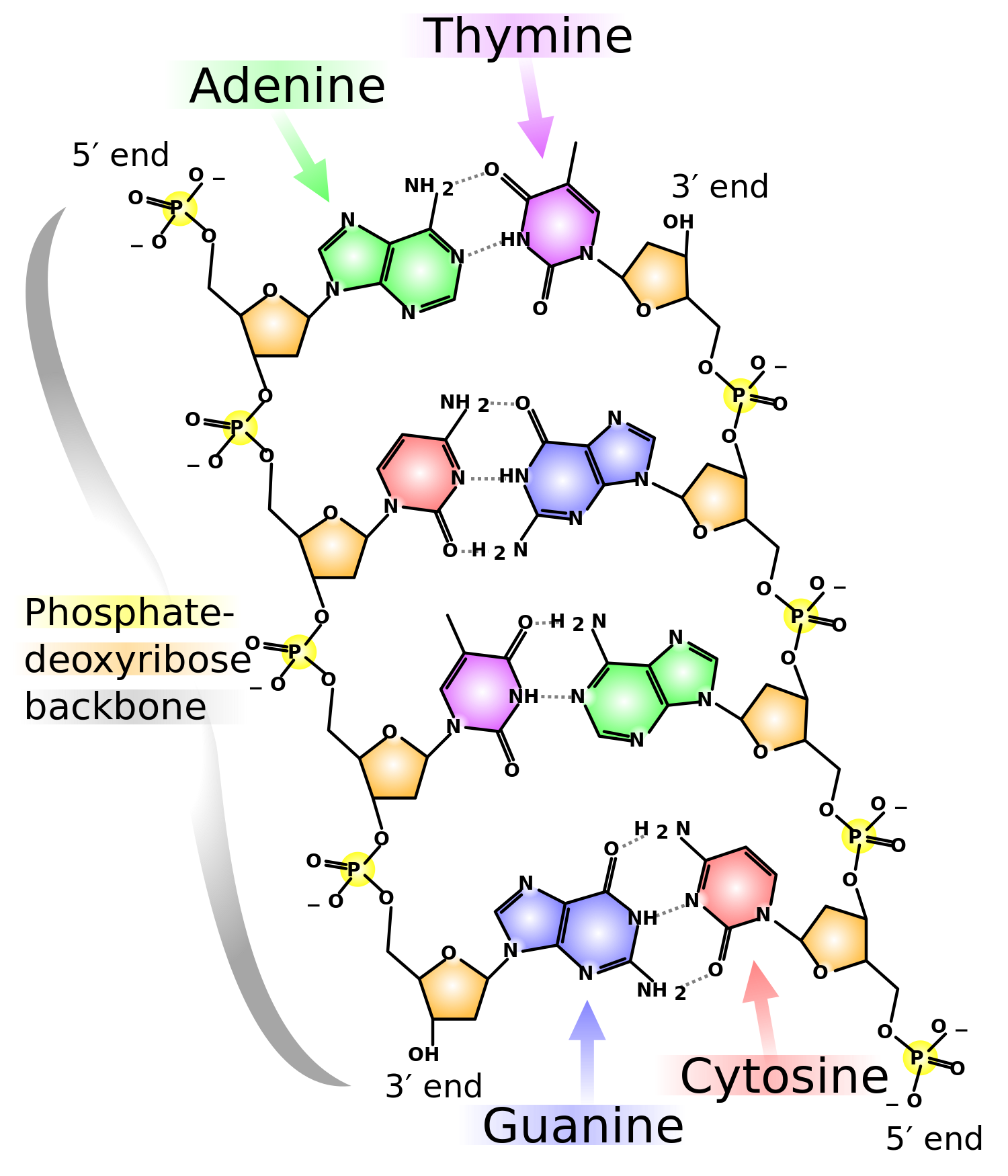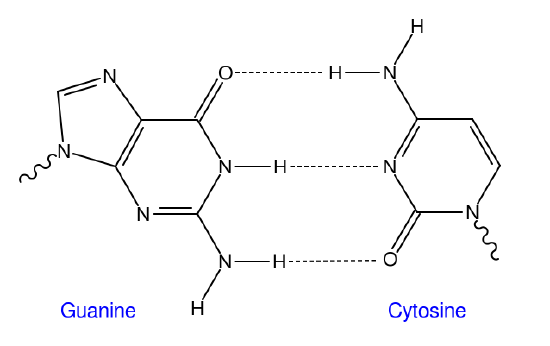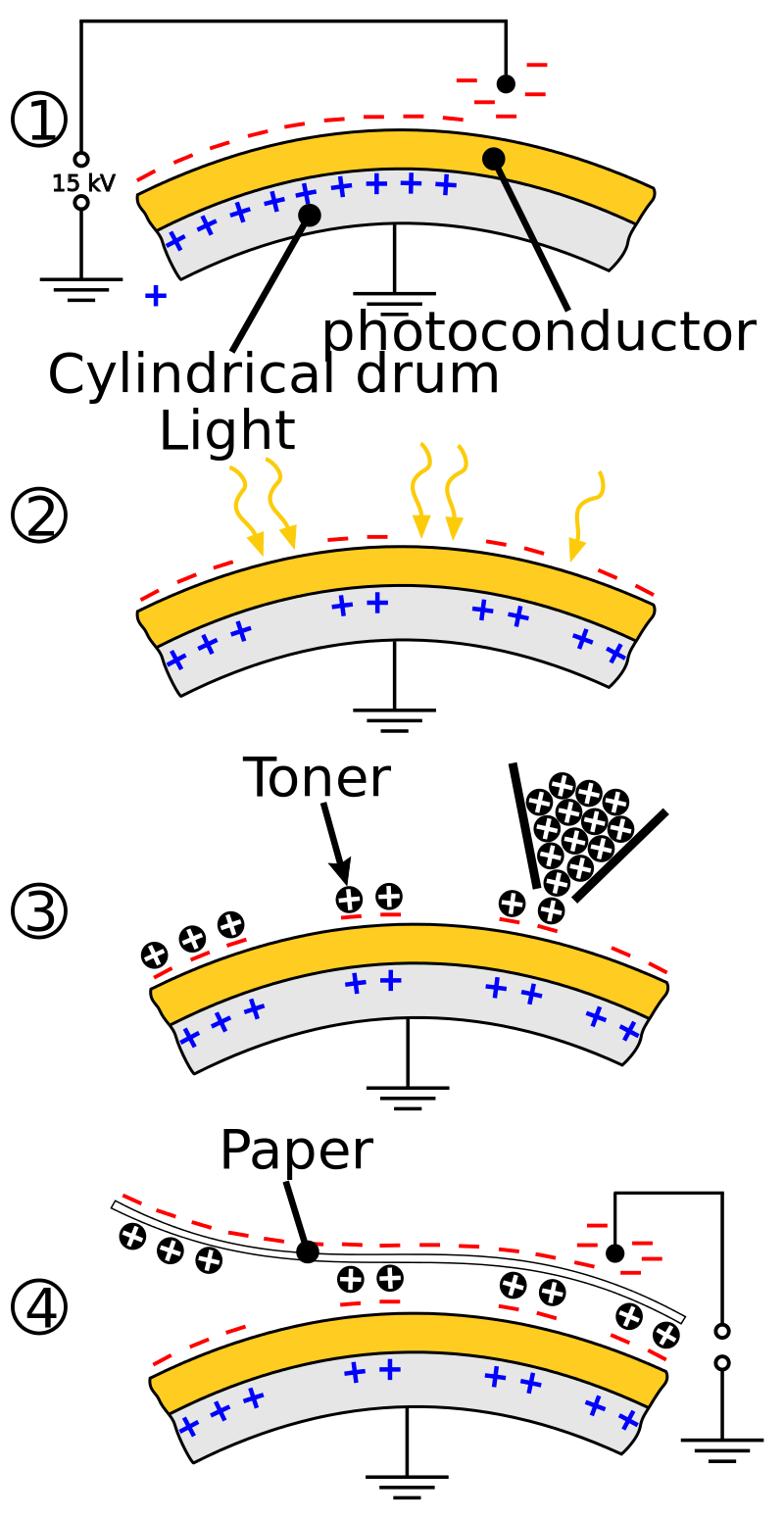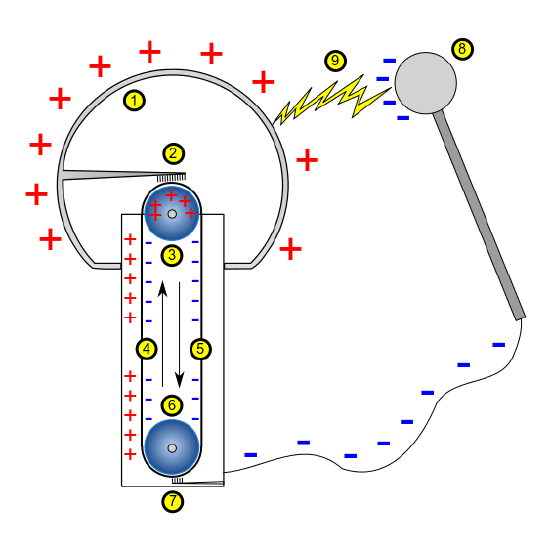17.6: Applications of Electrostatics
- Page ID
- 14548
learning objectives
- Describe effect of the DNA replication process on the hydrogen bonds
All living organisms contain either DNA or RNA. These molecules contain genetic information that defines (or at least influences) all of the organism’s characteristics. In both DNA and RNA, electrostatics plays a major role. For the purpose of this atom we focus specifically on DNA.
DNA is a large macromolecule that (in three-dimensional space) forms the shape of a double helix, as shown in. The “backbone” of each helix is formed from alternating deoxyribose and phosphate subunits as illustrated in. Each deoxyribose is connected to a base that extends between the two backbones. Four bases can be found in DNA: adenine, guanine, cytosine and thymine. Their ordering in sequence determines the genetic characteristics of the parent organism.

Phosphate in DNA: The complex molecules that make up our DNA are held together by a phosphate-deoxyribose backbone, as shown.
The bases of each strand of DNA are positioned close to one another but not as a result of formal chemical bonds. Electrostatic interactions, in this case otherwise known as hydrogen bonds, are what hold these bonds together.
In, (in the instance of guanine and cytosine) there are three instances in which hydrogen atoms are attracted to nearby nitrogen and oxygen atoms (denoted by dashed lines). For adenine and thymine, there are two such hydrogen bonds. These interactions can be modeled as electrostatic interactions—electrons from the oxygen and nitrogen atoms are negative, and are attracted to the exposed nuclei (which are positive) of the nearby hydrogen atoms. These hydrogen bonds are relatively weak, but their sum is strong enough to hold the two DNA strands together.

Hydrogen bonding between Guanine and Cytosine: In the instance of guanine and cytosine, there are three instances in which hydrogen atoms are attracted to nearby nitrogen and oxygen atoms (denoted by dashed lines).
When DNA replicates, as it does in cellular reproduction, it is first “unzipped” by any of a number of enzymes known as DNA Helicases. These enzymes break the electrostatic hydrogen bonds between the two strands.
Photocopy Machines and Printers
Photocopiers use xerography, a process that uses principles of electrostatics, to copy images.
learning objectives
- Describe functions of a photocopier and distinguish the three steps of xerography
A photocopier is a machine that prints copies of documents and images on paper. Currently, most photocopiers use a process called xerography, which is dry and uses heat in printing.
Different models of photocopiers vary somewhat in their methods, but the first instance of xerography involved use of a photosensor with a copy camera and a separate processing unit. To this day, xerography is conducted in a five-step process, in which electrostatics play an important role. This process is diagrammed in with explanations of each step outlined in the text below.

How a photocopier works: This image describes how a photocopier works.
Charging
In the first step of xerography, a high-voltage device (either a corona wire or charge roller) charges a cylindrical drum. This occurs by corona discharge, with output limited by a control grid or screen: a negative charge on the wire ionizes the space between the wire and conductor, so electrons are repelled and pushed onto the conductor. The conductor is put on top of a conducting surface and is kept at ground potential.
Polarity of charge can be altered depending on desired effects. A positive process is used to produce black on white copies, while a negative process is used to produce black on white from negative originals.
Exposure
A lamp illuminates the original document. The white areas of the original reflect light onto the surface of the drum, which exhibits photoconductivity (it becomes a conductor in the presence of light). The areas of the drum exposed to light then discharge to the ground; the other parts of the drum (which are not conductive, having not been exposed to light) remain negatively charged. Thus, the result is an electric image on the surface of the drum.
Developing
The toner, a powder used to form images on the paper, is positively charged. When it is placed on the drum, it is attracted to the negative (black) areas. This develops the image.
Transfer
The image with toner on the drum is transferred to a piece of paper with more negative charge than the drum.
Fusing
The toner is melted and bonded to the paper by heat and pressure rollers.
It should be noted that the explanation above is typical for modern copiers, but some older copiers use a positive drum and paper, and a negatively charged toner.
Van de Graff Generators
A Van de Graaff generator is a device that can be used to separate charges and create potential differences in the range of megavolts.
learning objectives
- Identify and describe functions of the major parts of a Van de Graaff generator
A Van de Graaff generator is a device used to separate electric charges. Using a moving belt, it can create extremely high potential differences. In some cases these can reach a value in excess of five megavolts.
Fundamentally, a Van de Graaff generator consists of a flexible dielectric belt (silk is commonly used) running over two metal pulleys. One of these pulleys is surrounded by a hollow metal sphere. Two electrodes are positioned near the bottom of the lower pulley and inside the sphere, over the upper pulley. One comb is connected to the sphere, and another is connected to the ground. In this figure, a high, positive DC potential is applied to the upper roller.

Schematic of a Van de Graaff Generator: Numbers in the diagram indicate: 1) hollow metal sphere; 2) upper electrode; 3) upper roller (for example an acrylic glass); 4) side of the belt with positive charges; 5) opposite side of the belt with negative charges; 6) lower roller (metal); 7) lower electrode (ground); 8) spherical device with negative charges, used to discharge the main sphere; 9) spark produced by the difference of potentials
The separation of charge in a Van de Graaff generator is a complex, multistep process. Due to the electric field around the lower pulley, the belt receives negative charge as it passes the lower comb. When the belt comes into contact with the upper roller, it leaves the roller with a negative charge as electrons are transferred. Electrons seep from the belt to the upper comb and then the terminal, leaving the belt positively charged and the terminal negatively charged. The sphere acts as a Faraday shield, shielding the upper roller and comb from the electric field produced by charges on the outside of the sphere. Eventually, discharge occurs, and the belt changes polarity. As the belt continues, a charging current travels via the belt, and the sphere takes on more and more negative charge until the rates at which it gains and loses charge (which occurs by leakage and corona discharge) are equal. Final potential is proportional to the size of the sphere and its distance from the ground.
Key Points
- In DNA, hydrogen bonds between base pairs hold two opposite strands together.
- The hydrogen bonds that hold DNA together are electrostatic interactions between the nucleus of a hydrogen atom and the electrons of an oxygen or a nitrogen atom.
- When DNA replicates, a helicase enzyme “unzips” the double helix, breaking the hydrogen bonds that hold it together in the center.
- In the first step of xerography, a high-voltage device (either a corona wire or charge roller) charges a cylindrical drum.
- In the second step, a lamp illuminates the original document. The white areas of the original reflect light onto the surface of the drum, which is photoconductive. The areas of the drum exposed to light then discharge to the ground.
- Next, the toner, a positively-charged powder used to form images on the paper, is placed on the drum. It is attracted to the negative (black) areas. This develops the image.
- The image with toner on the drum is then transferred to a piece of paper with more negative charge than the drum.
- Finally, the toner is melted and bonded to the paper by heat and pressure rollers.
- Fundamentally, a Van de Graaff generator consists of a flexible dielectric belt (silk is commonly used) running over two metal pulleys.
- The belt is used to transport charge, isolating positive charge from negative charge.
- The maximum potential difference a Van de Graaff generator can create is achieved when the rates at which the sphere (which holds charge) gains and loses charge are equal. Charge can be lost by leakage and corona discharge.
Key Terms
- base: A nucleotide’s nucleobase in the context of a DNA or RNA biopolymer.
- photoconductivity: An increase in the electrical conductivity of a material as a result of incident electromagnetic radiation
- xerography: a photocopying process in which a negative image formed on an electrically charged plate is transferred as a positive to paper and thermally fixed
- Faraday shield: A Faraday cage or Faraday shield is an enclosure formed by conducting material or by a mesh of such material. Such an enclosure blocks external static and non-static electric fields.
- polarity: the separation, alignment or orientation of something into two opposed poles
- corona discharge: an electrical discharge brought on by the ionization of a fluid surrounding a conductor that is electrically energized
LICENSES AND ATTRIBUTIONS
CC LICENSED CONTENT, SHARED PREVIOUSLY
- Curation and Revision. Provided by: Boundless.com. License: CC BY-SA: Attribution-ShareAlike
CC LICENSED CONTENT, SPECIFIC ATTRIBUTION
- Andrew Hughes, Primary DNA Molecular Structure. September 18, 2013. Provided by: OpenStax CNX. Located at: http://cnx.org/content/m11411/latest/. License: CC BY: Attribution
- Hydrogen bond. Provided by: Wikipedia. Located at: en.Wikipedia.org/wiki/Hydrogen_bond. License: CC BY-SA: Attribution-ShareAlike
- Boundless. Provided by: Boundless Learning. Located at: www.boundless.com//chemistry/definition/base. License: CC BY-SA: Attribution-ShareAlike
- GC DNA base pair. Provided by: Wikipedia. Located at: en.Wikipedia.org/wiki/File:GC_DNA_base_pair.svg. License: CC BY: Attribution
- File:DNA chemical structure.svg - Wikipedia, the free encyclopedia. Provided by: Wikipedia. Located at: en.Wikipedia.org/w/index.php?title=File:DNA_chemical_structure.svg&page=1. License: CC BY-SA: Attribution-ShareAlike
- Xerography. Provided by: Wikipedia. Located at: en.Wikipedia.org/wiki/Xerography. License: CC BY-SA: Attribution-ShareAlike
- photoconductivity. Provided by: Wiktionary. Located at: en.wiktionary.org/wiki/photoconductivity. License: CC BY-SA: Attribution-ShareAlike
- xerography. Provided by: Wiktionary. Located at: en.wiktionary.org/wiki/xerography. License: CC BY-SA: Attribution-ShareAlike
- GC DNA base pair. Provided by: Wikipedia. Located at: en.Wikipedia.org/wiki/File:GC_DNA_base_pair.svg. License: CC BY: Attribution
- File:DNA chemical structure.svg - Wikipedia, the free encyclopedia. Provided by: Wikipedia. Located at: en.Wikipedia.org/w/index.php?title=File:DNA_chemical_structure.svg&page=1. License: CC BY-SA: Attribution-ShareAlike
- Xerographic photocopy process en. Provided by: Wikipedia. Located at: en.Wikipedia.org/wiki/File:Xerographic_photocopy_process_en.svg. License: CC BY-SA: Attribution-ShareAlike
- Van de Graaff generator. Provided by: Wikipedia. Located at: en.Wikipedia.org/wiki/Van_de_Graaff_generator. License: CC BY-SA: Attribution-ShareAlike
- polarity. Provided by: Wiktionary. Located at: en.wiktionary.org/wiki/polarity. License: CC BY-SA: Attribution-ShareAlike
- corona discharge. Provided by: Wikipedia. Located at: en.Wikipedia.org/wiki/corona%20discharge. License: CC BY-SA: Attribution-ShareAlike
- Faraday shield. Provided by: Wikipedia. Located at: en.Wikipedia.org/wiki/Faraday%20shield. License: CC BY-SA: Attribution-ShareAlike
- GC DNA base pair. Provided by: Wikipedia. Located at: en.Wikipedia.org/wiki/File:GC_DNA_base_pair.svg. License: CC BY: Attribution
- File:DNA chemical structure.svg - Wikipedia, the free encyclopedia. Provided by: Wikipedia. Located at: en.Wikipedia.org/w/index.php?title=File:DNA_chemical_structure.svg&page=1. License: CC BY-SA: Attribution-ShareAlike
- Xerographic photocopy process en. Provided by: Wikipedia. Located at: en.Wikipedia.org/wiki/File:Xerographic_photocopy_process_en.svg. License: CC BY-SA: Attribution-ShareAlike
- Van de graaf generator. Provided by: Wikipedia. Located at: en.Wikipedia.org/wiki/File:Van_de_graaf_generator.svg. License: CC BY-SA: Attribution-ShareAlike


